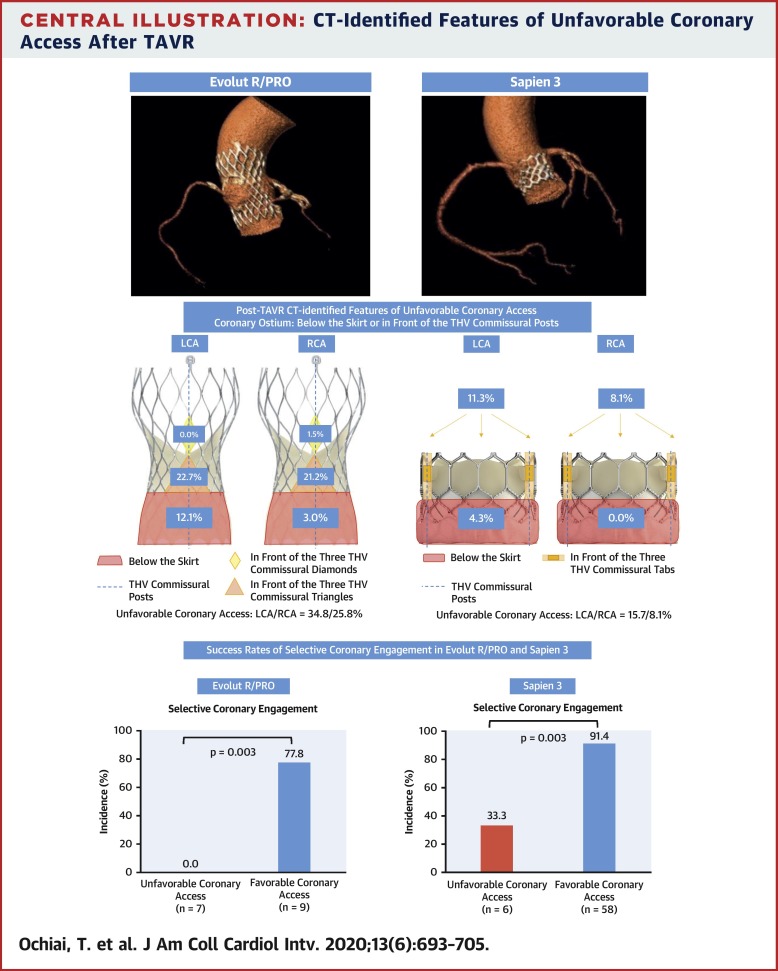JACC: Cardiovascular Interventions ( IF 11.7 ) Pub Date : 2020-03-16 , DOI: 10.1016/j.jcin.2020.01.216 Tomoki Ochiai 1 , Tarun Chakravarty 2 , Sung-Han Yoon 2 , Danon Kaewkes 2 , Nir Flint 3 , Vivek Patel 2 , Sahar Mahani 2 , Ripandeep Tiwana 2 , Navjot Sekhon 2 , Mamoo Nakamura 2 , Wen Cheng 2 , Raj Makkar 2

|
Objectives
The aim of this study was to assess the incidence of unfavorable coronary access after transcatheter aortic valve replacement (TAVR) using post-implantation computed tomography (CT).
Background
Real-world data regarding coronary access after TAVR assessed using post-implantation CT are scarce.
Methods
Post-TAVR CT of 66 patients treated with Evolut R or Evolut PRO valves and 345 patients treated with SAPIEN 3 valves were analyzed. The distance from inflow of the transcatheter heart valve (THV) to the coronary ostia and the overlap between THV commissures and the coronary ostia were assessed. Coronary access was defined as unfavorable if the coronary ostium was below the skirt or in front of the THV commissural posts above the skirt in each coronary artery.
Results
CT-identified features of unfavorable coronary access were observed in 34.8% (n = 23) for the left coronary artery and 25.8% (n = 17) for the right coronary artery in the Evolut R/Evolut PRO group, while those percentages were 15.7% (n = 54) for the left coronary artery and 8.1% (n = 28) for the right coronary artery in the SAPIEN 3 group. In the Evolut R/Evolut PRO group, 16 coronary engagements were performed after TAVR, while 64 coronary engagements were performed in the SAPIEN 3 group after TAVR. In an engagement-level analysis, the success rates of selective coronary engagement were significantly lower in patients with CT-identified features of unfavorable coronary access compared with those with favorable coronary access in both the Evolut R/Evolut PRO (0.0% vs. 77.8%; p = 0.003) and SAPIEN 3 (33.3% vs. 91.4%; p = 0.003) groups.
Conclusions
Coronary access may be challenging in a significant proportion of patients after TAVR. THVs with low skirt or commissure height and large open cells that are designed to achieve commissure-to-commissure alignment with the native aortic valve may facilitate future coronary access. (Assessment of Transcatheter and Surgical Aortic Bioprosthetic Valve Thrombosis and Its Treatment With Anticoagulation [RESOLVE]; NCT02318342)
中文翻译:

TAVR后的冠状动脉通路。
目标
这项研究的目的是使用植入后计算机断层扫描(CT)评估经导管主动脉瓣置换(TAVR)后不利的冠状动脉通路的发生率。
背景
使用植入后CT评估TAVR后有关冠状动脉通路的真实数据很少。
方法
TAVR后CT分析了66例使用Evolut R或Evolut PRO瓣膜治疗的患者和345例使用SAPIEN 3瓣膜治疗的患者。评估了从经导管心脏瓣膜(THV)流入到冠状动脉口的距离以及THV连合与冠状动脉口之间的重叠。如果冠状动脉口位于裙部以下或每个冠状动脉中裙部上方的THV连合柱前方,则冠状动脉进入被定义为不利。
结果
在Evolut R / Evolut PRO组中,左冠状动脉的34.8%(n = 23)和右冠状动脉的25.8%(n = 17)观察到CT识别的不利冠状动脉进入特征,而这些百分比为15.7在SAPIEN 3组中,左冠状动脉的%(n = 54)和右冠状动脉的8.1%(n = 28)。在Evolut R / Evolut PRO组中,TAVR后进行了16次冠状动脉介入治疗,而SAPIEN 3组中TAVR后进行了64次冠状动脉介入治疗。在参与度分析中,在Evolut R / Evolut PRO中,CT识别出的冠状动脉入路不良的患者与具有良好冠脉入路的患者相比,选择性冠状动脉入路的成功率明显较低(0.0%比77.8% ; p = 0.003)和SAPIEN 3(33.3%vs. 91.4%; p = 0.003)组。
结论
TAVR后,相当大比例的患者可能难以接受冠状动脉通路。具有低裙边或连合高度的THV和大型开孔设计用于实现与自然主动脉瓣的连合对齐的THV可能有助于将来的冠状动脉通路。(经导管和外科主动脉生物瓣膜血栓形成的评估及其抗凝治疗[RESOLVE]; NCT02318342)











































 京公网安备 11010802027423号
京公网安备 11010802027423号